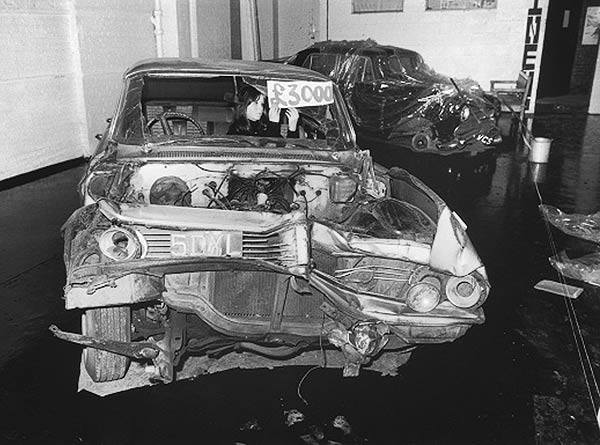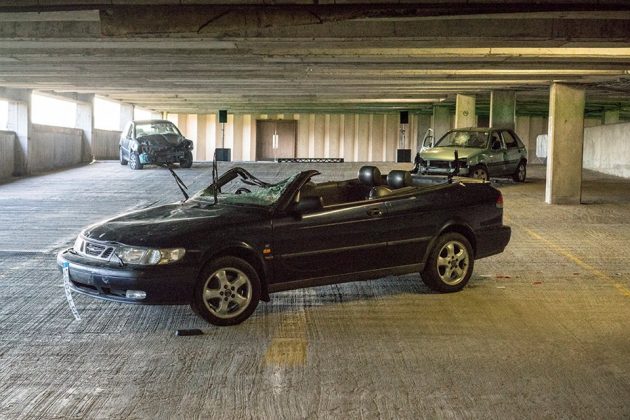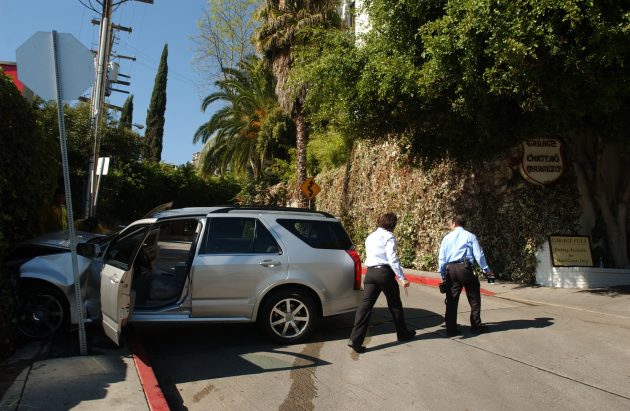STEPHEN BAYLEY on CRASHED CARS and the DEATH OF THE MODERN ERA
Death is the most banal event imaginable:
A) it comes to everyone
and
B) it ends in the dirt.
But the death of a celebrity, in a fast car, down some black night street, lit up in the bright silver of a paparazzo’s flash bulb, was, during the short twentieth century, the last word in romantic tragedy. When the car was king, and the rich and famous were demigods high on Olympus, rather than TMZ fodder, the car crash was the most Modern of ends. The very finest of tragedies: an Icarus, for an age of combustion engines, mass democracy, and the jet set.
Because if the car symbolises, ultimately, personal freedom via explosive technology, what more extreme freedom is there than the right to drive, at speed, into a tree?
This is the argument design critic and historian Stephen Bayley advances in his book Death Drive: There Are No Accidents. A requiem for the machine age, told as a set of elegies for 20th century icons killed in motor accidents.As the private car – gas-guzzling, ferocious, fast – seems more and more like last century’s boy, Bayley relates the absurd, cosmically aligned tragedies of their passing. James Dean dying on the road after shooting a motor-safety PSA, Camus with a train ticket in his pocket, Jean Bugatti in a final spin of a test car, outside his father’s eponymous factory – fodder for either JG Ballard’s ideas of mysterious alignment, or Carl Gustav Jung’s aphorism that there are no accidents.

On the subject of Ballard, recently Bayley spoke at the opening of a restaging of the author’s exhibition 1970 exhibition Crashed Cars (above), on now at Bold Tendencies in Peckham, London. 032c spoke to him before:
Why now?
The idea of doing this book has been on my mind for years: I’ve always had a macabre fascination with it, but and it’s come about because I finally could persuade a publisher to do it. I touted it around a lot of mainstream publishers who said it’s too gruesome to do, and now I found a specialist house who had the nerve to do it, the books in print. But it is sort of timely, because it is five minutes to midnight for the private car.
I think we can see so many indicators of that: individuals are driving less and less. The gross amount of miles driven is inching up and up, but people are driving less, and the more ‘developed’ the culture, the less people are driving. There was a wonderful thing I heard themayor of Bogota say the other day, when he said “the mark of an advanced society isn’t when the poor drive cars, it’s when the rich take public transport,” and I have to agree with him. The autonomous car is probably coming – there are considerable technological and legal difficulties, but when that arrives, the sordid, hot, dirty, dangerous romance of a car will be over. The oil burning engine is man’s most absurd but difficult invention. It’s the ultimate analogue machine: you proceed down a road in a series of explosions. It’s absurd: even in mechanical engineering terms, the reciprocating engine is ludicrous. But, but, but … It confers extraordinary power onto the machines it powers. Driving is in itself an analogue experience, and being killed in a car crash is the ultimate analogue experience.
And celebrity – at least the distant, glamorous, black-and-white version covered in the book – is, in itself, pretty analogue, right? The book is about movie stars, rock musicians and the car. All of these are absolutely 20th century objects.
Celebrities don’t drive any more! This book is about about remarkable people and their catastrophic ends. But it’s also about the end of an era, when people used a car to express themselves. When the autonomous vehicle comes about, it might have practical benefits, particularly if you’re blind drunk, but it is not going to be an expression of your personality, your status, or your yearnings. So it’s not so much about the death of the individuals concerned, it’s about the death of the car as a status attribute. Looking back, I see it as a very romantic period. Rock music, movies, and the car, as the most interesting aspect of industrial design: these are the three most defining art forms of our civilisation. And they are all coming to an end.
You are viewing the end of Modernism through the most destructive, terrifying part of that trinity: cars are one-tonne objects, which explode, in order to propel them at enormous speeds. Would they have the same romance were they not so unbelievably dangerous?
No, absolutely not, I agree. That’s why cars are so fascinating. The only truth in marketing is that consumers behavior is irrational. I heard Damon Hill, the racing driver say that “Motor car racing is the most irresponsible, dangerous unpardonably indulgent, reckless: and that’s exactly why it’s interesting.” God knows, I’m not trying to glorify death or violence in this book, but there’s something touching about the fact that all of these deaths were premature, as all deaths by accident are by their nature premature. There’s something haunting about it, because in a car, the psychology of it is that you are both in a secluded, private space, but also on show, in public, and it’s that tension between the concealment and display that you enjoy in a car, and once that security is evaporated by a violent calamity, that becomes extremely interesting as well. The car’s fascination has always been dependent on irrationality and danger. When we are all being driven around in injection-moulded pods, powered by Google, it may be clean, safe and responsible, but it will be boring.

One of the things that struck me about this is that reminded me of that film Mad Max – did you watch that at all?
No, I’m afraid I didn’t.
Oh, you should! It’s basically a 1930s German expressionist film hiding within a 2010s blockbuster, it’s a really strange, very riveting thing. Anyway: it shows the ultimate analogue apocalypse: the world has ended, but cars still work. But of course, the first thing to happen in the end of the world would be the smart cars stopping, then the maps function going offline.
It’s impossible to get lost these days. And we have lost some key thing of romance. It’s awful to know where you are all the time. The great age of car allowed you to do that. To go out and head into the horizon. The modern car was invented in the midwest, and you go out there, and see these enormous plains, and you can sense exactly what Henry Ford had in mind when he said “I had to invent the gasoline buggy to escape the boredom of life on the farm.” That’s what cars have always been: against boredom.
Which leads us naturally to sex. Cars have always been about this, from the makeup spots in 50s movies, to Crash.
Self-expression, the control of power, these are all things we enjoy when we drive a car, and they have their exact equivalent in sexual relations too.
It’s striking the number of stories in the book that are marked by this: from an affair, to rumoured congress taking place during the crash, it’s a theme running through the book.
The most important part of driving and sex is about romance and adventure. It’s about possibilities. It was a beautiful moment. Owning and driving a car provided the ultimate modernist experience: it was popular, it was democratic, it was liberating. And it’s soon becoming a thing of the past.
In Teenage, Jon Savage said that almost every book released in the 1920s by a Bright Young Thing had a car crash at its centre. Why do you think the car crash as an object is so fascinating?
Destroyed promise. These people in my book were all on interesting personal missions of escape, usually. We all know the voyeuristic fascination we all have when we spot an accident on the road: the accidents of the famous are this, super-sized. In most of literature, in most of story-telling, the individual on a mission who meets calamity because of forces outside of their control – that’s what it’s all about.
The subtitle of the book is taken from something Karl Gustav Jung said: There Are No Accidents. Our lives, to a degree we don’t understand, are predetermined. Perhaps I’m guilty of a bit of over interpretation here and there, but I’ve tried to weave an element of that into the book: that people are meeting their destiny here. There are extraordinary things like in the Nathaniel West chapter. Nathaniel West – always one of my favourite novelists – best friend of F Scott Fitzgerald, Fitzgerald dies suddenly, and Nathaniel West breaks off his shooting trip in Mexico to drive to the funeral, and whoever would have though how Nathaniel West was going to die.
It’s striking how many of the deaths are almost – and this is not an easy thing to say – but almost too perfect. The writer who encapsulates the danger and promise of the moment post-1918 – who features a car-crash at the centre of his greatest novel – inadvertently kills his friend-cum-protege in a car-crash.
You can say why Jung said it: it’s the theory of mysterious alignment that Ballard spoke about. Ballard is always going on about how our lives and destinies are pre-determined. You’re Eddie Cochrane, you’ve written this hugely successful rockabilly number about a Ford, and the glamour of whichever Ford he’s dreaming about, probably the 1959 Galaxie Skyliner, and you end up dying, not on Sunset Blvd, or some Pacific Coast highway, in a British Ford Consul on the A4 in Chippenham. It’s utterly extraordinary.
Camus said there would be nothing more absurd than to die in a car crash. And what happens? Camus dies in a car crash. It’s majestical beautiful. In his suit pocket, there was an unused train ticket for the journey he was on, from Provence to Paris. It’s like an Albert Camus story itself.

One thing I wanted to ask was about Helmut Newton: a photographer that looked at modernism in this very post-modern way, he dies just as the 20th century is over, and the book ends.
One of Newton’s most famous works is called Me and my Cadillac, of a woman pleasuring herself on the tailfin of a Cadillac. He’s made his exploitation of women, his deluxe pornography, his car … And talk about bathos: how could you end up crashing your Cadillac in a hotel carpark? It’s hard to think of other celebrity car crashes after, but it’s quite hard to do. I mean, Paul Walker, perhaps, but he wasn’t a great celebrity. Clearly the era was over, and Helmut Newton marks the end of that era.
What else marks this as end of an era?
It’s le monde a l’envers, as the French would say: the world turned upside down. Once, if you were very sophisticated, you travelled a lot, now, if you were very sophisticated you travel a lot less. Travel-related deaths are not going to be a pattern in the future. The celebrity car-crash – a great person in a great car in a great place – is the ultimate modernist moment. And modernism is now a historical moment.
People will still get hit by cars of course.
I got knocked off my feet just this morning by a man in a Peugeot van. It’s a chilling experience. I wondered if I was going to meet my maker, this way of all ways. And I was saying to my publicist, that in one of Albert Camus’s short stories, there is a failed novelist who commits suicide in order to draw attention to his work, and I thought if I could arrange a big but non-fatal car accident, it would be a fantastic hook. As a footnote, I should say that I’m an extremely cautious driver.
I should think so, after writing the book! Better put the seatbelt on after getting in the Bugatti.
I must say that like James Dean, I’m a keen advocate of road safety, but I’ve deliberately not dwelled on this: the book is not about road safety. That’s for another writer at another time: what’ve done here istry to capture a very specific moment: a moment of Modernism, or the age of combustion as I call it. I’m very far from being obsessed by celebrities, but celebrity is part of my story, and celebrity was also a product of this analogue culture: the car, the person, and the moment combining to make, I think, I rather elegiac story. And the version of celebrity I look at in the book is as much a function of that experience. And it’s now over.